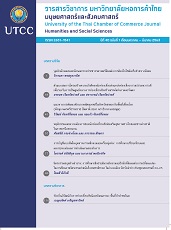Structural Equation Model of Tourist Loyalty toward Dvaravati Civilization Tourist Attraction to be served as a Center of Western Creative Tourism
Main Article Content
Abstract
This research aimed to study the influence on tourist loyalty towards Dvaravati civilization attractions and finding a guideline for creating the loyalty towards Dvaravati civilization attractions. These mixed methods combined with a quantitative and qualitative research. According to the results, it was found that the tourism motivation had a positive direct influence on the tourism satisfaction; the tourism image had a positive direct influence on the tourist loyalty; the tourism satisfaction had a positive direct influence on the tourist loyalty; and the tourism motivation had an indirect influence on the tourist loyalty through tourism satisfaction. With regard to the guideline for creating the loyalty towards the attractions, the operation should be carried out in 3-stage plan as follows: 1st Stage: Tourism improvement plan to attract tourists to visit Dvaravati civilization attractions, 2nd Stage: Tourism promotion plan to increase the number of tourists in Dvaravati civilization attractions, and 3rd Stage: Tourism sustainability development plan to attract new customer groups and increase the return rate of tourists which will affect the tourism and circular economy to be prosperous and sustainable to support the creative tourism center.
Article Details
ลิขสิทธิ์ของบทความ
ผลงานที่ได้รับการตีพิมพ์ถือเป็นลิขสิทธิ์ของมหาวิทยาลัยหอการค้าไทย ห้ามมิให้นำเนื้อหา ทัศนะ หรือข้อคิดเห็นใด ๆ ของผลงานไปทำซ้ำ ดัดแปลง หรือเผยแพร่ ไม่ว่าทั้งหมดหรือบางส่วนโดยไม่ได้รับอนุญาตเป็นลายลักษณ์อักษรจากมหาวิทยาลัยหอการค้าไทยก่อน
References
Changsu, K., Robert D, G., Namchul, S., Joo-Han, R., & Jongheon, K. (2012). Factors influencing Internet shopping value and customer repurchase intention. Electronic Commerce Research and Applications, 11(4), 374-387.
Chen, C-F., & Chen, F-S. (2010). Experience quality, perceived value, satisfaction and behavioral intentions for heritage tourists. Tourism Management, 31(1), 29-35.
Chen, C. F., & Tsai, D. C. (2007). How destination image and evaluative factors affect behavioral intentions. Tourism Management, 28, 1115-1122.
Forgas-Coll, S., Palau-Saumell, R., Sánchez-García, J., & Callarisa-Fiol, L. J. (2012). Urban destination loyalty drivers and cross-national moderator effects: The case of Barcelona. Journal Tourism Management, 33, 1309-1320.
Gallarza, M. G., & Saura, I. G. (2006). Value dimensions, perceived value, satisfaction and loyalty: An investigation of university students’ travel behaviour. Tourism Management, 27(3), 437-452.
Hutchinson, J., Lai, F., & Wang, Y. (2009). Understanding the relationships of quality, value, equity, satisfaction, and behavioral intentions among golf travelers. Tourism Management, 30, 298-308.
Lien, C. H., & Cao, Y. (2014). Examining we chat users’ motivations, trust, attitudes, and positive word-of-mouth: Evidence from China. Computers in Human Behavior, 41, 104-111.
Lin, Y., Lee, Y., & Wang, S. (2012). Analysis of motivation, travel risk, and travel satisfaction of Taiwan undergraduates on work and travel overseas programmers. Tourism Management Perspectives, 2-3, 35–46.
López-Guzmán, T., Gálvez, J. C. P., & Muñoz-Fernández, G. A. (2018). Satisfaction, motivation, loyalty and segmentation of tourists in world heritage cities. Revista de Turismo y Patrimonio Cultural, 16(1), 73-86.
Loureiro, S. M. C., & Gonzalez, F. J. M. (2008). The importance of quality, satisfaction, trust, and image in relation to rural tourist loyalty. Journal of Travel and Tourism Marketing, 25(2), 117-136.
Mai, N. K., & Huynh, T. T. H. (2014). The influences of push and pull factors on the international leisure tourists’ return intention to Ho Chi Minh City, Vietnam: A mediation analysis of destination satisfaction. International Journal of Trade, Economics and Finance, 5(6), 490-496.
Myung, J., Namho, B., & Choong, K.L. (2011). The effect of perceived trust on electronic commerce: Shopping online for tourism products and services in South Korea. Tourism Management, 32(11), 256–265.
Ozturk, A. B., & Qu, H. (2008). The impact of destination images on tourists’ perceived value, expectations, and loyalty. Journal of Quality Assurance in Hospitality and Tourism, 9(4), 275-297
Patricia, M., & Ignacia, R. D. B. (2013). CSR and customer loyalty: The roles of trust, customer identification with the company and satisfaction. Journal of Hospitality Management, 35, 89-99.
Qu, H., Kim, L. H., & Im, H. H. (2011). A model of destination branding: Integrating the concepts of the branding and destination image. Tourism Management, 32, 464-476.
Sanghyun, K., & Hyunsun, P. (2013). Effects of various characteristics of social commerce (s-commerce) on consumers’ trust and trust performance. International Journal of Information Management, 33(2), 318-332.
Suki, N. M. (2014). Passenger satisfaction with airline service quality in Malaysia: A structural equation modeling approach. Research in Transportation Business & Management, 10, 26-32.
Yamane, T. (1967). Statistics, An introductory analysis. New York, NY: Harper and Row.
Yoon, Y., & Uysal, M. (2005). An examination of the effects of motivation and satisfaction on destination loyalty: A structural model. Tourism Management, 26, 45-56.
Zhang, X. (2012). The factors effecting Chinese tourist revisit Thailand destination (Unpublished master’s thesis). University of the Thai Chamber of Commerce, Bangkok.
Zhuangyu, L., Abdur, R., Banghong, Z., & Jianqiang, P. (2016). Analysis of the relationship between tourist motivation, satisfaction and loyalty for China special theme tourism. Asian Research Journal of Arts & Social Sciences, 1(5), 1-14.
รัชฎา จิรธรรมกุล. (2559). แนวทางการพัฒนาแหล่งท่องเที่ยวชุมชนเชิงสร้างสรรค์ด้านวัฒนธรรม ในชุมชนบ้านแขนน อำเภอถลาง จังหวัดภูเก็ต. วารสารกระแสวัฒนธรรม, 17(31), 3-17.
วิวัฒน์ จันทร์กิ่งทอง. (2557). ทฤษฎีพฤติกรรมตามแผนกับความภักดีของนักท่องเที่ยว. วารสารมหาวิทยาลัยศิลปากร ฉบับภาษาไทย, 34(2), 131-146.
สำนักงานปลัดกระทรวงการท่องเที่ยวและกีฬา. (2561). แผนปฏิบัติการขับเคลื่อนการพัฒนาการท่องเที่ยวโดยชุมชนอย่างยั่งยืนและสร้างสรรค์ พ.ศ. 2561- 2565. กรุงเทพฯ: ผู้แต่ง.
สำนักบริหารยุทธศาสตร์กลุ่มจังหวัดภาคกลางตอนล่าง 1. (2559). แผนพัฒนากลุ่มจังหวัดภาคกลางตอนล่าง 1. กรุงเทพฯ: ผู้แต่ง.


